DJI Phantom 4 Drone Review
Novice pilots will love the simple control and flying of the Phantom 4, and experienced pilots will like the power and speed.
Why you can trust Tom's Guide
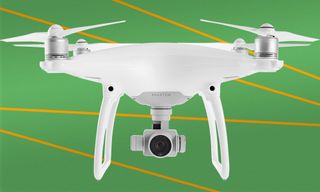
While the flying smarts of the DJI Phantom 4 haven't reached Terminator levels yet, DJI's drone seems to be on the verge of gaining sentience. The $1,399 drone's new features will help novice fliers get off the ground, with the help of its object-avoidance system and smart camera that can track and follow subjects. Experienced fliers will appreciate that the new model is significantly faster and lasts longer on a charge than the Phantom 3. However, the technology isn't foolproof nor completely intuitive to use.
Design
The Phantom 4 keeps the sleek, white design of previous models, but it has put on a little weight. With a takeoff weight of 3.06 pounds and measuring 19.25 inches from rotor tip to tip, it is about the same size as the Phantom 3 (2.69 pounds), though it's slightly heavier. Overall, it's aerodynamically designed, and the glossy finish screams luxury. This weight also means that you will need to register it with the FAA before you fly it outside.
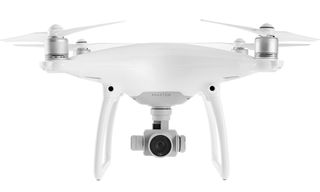
The majority of this weight comes from the battery. A hefty chunk of lithium-ion-polymer chemistry slides into the body of the drone and locks into place with two catches. This battery holds a sizable 5,350 mAh of charge — an increase from the 4,800 mAh for the Phantom 3 battery. DJI has changed the design of the battery here as well; you can't use Phantom 3 batteries with the Phantom 4.
There are a number of new sensors around the quadcopter body, with two small cameras on the front near the legs, and two more cameras and two ultrasonic sensors on the base. The small cameras and ultrasonic sensor form what DJI calls the object and vision positioning system: They see objects in front of and below the drone, which takes that data, interprets it and tries to avoid collisions.
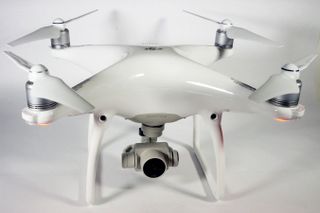
On one side of the quadcopter's body are the microSD card slot and a micro-USB port, used for updating the firmware. Neither of these is covered, which means they are exposed to dirt or water in a hard landing.

The gimbal that holds the camera and keeps it level as the quadcopter pans and tilts has also changed, with a much cleaner design than the Phantom 3 and few exposed parts. All of the cabling and gears of the gimbal mechanism are hidden away behind an aluminum case. The rubber cushions that protect the camera from the vibrations of the body are now hidden inside the quadcopter's body. As for the camera, it's smaller than a GoPro — about the size of a cellphone battery, with a large lens protruding from the front.
Specs:
Rotors: 4 (2 blades per rotor), 5-inch diameter
Battery Size: 5,350-mAh Lithium Polymer
Battery Life: 28/24 min (claimed/tested)
Camera: 4k/60p, 1080p/120 fps
Smartphone Controlled: Yes
FAA Registration: Yes
Size: 19.25 x 19.25 x 8 inches (Rotor tip to top)
Weight: 3.06 pounds
Controller
DJI redesigned the controller to be smaller and more compact than the ones on previous Phantoms. It has the same clean, white aesthetic as the quadcopter, with two large Wi-Fi antennas and a holder for a cellphone or tablet on the top. The sides and back are covered with soft-grip plastic, which makes it comfortable and easy to hold, even when you have to take one hand off the controller to touch the screen of the cellphone or tablet.
Flying Phantoms has always been a simple process, and the Phantom 4 continues this hassle-free flight experience.
There is no screen on the controller; video previews and other information are shown on the DJI Go app (Android and iOS) that accompanies the drone. Instead, the controller is bristling with buttons, knobs and dials for controlling the quadcopter. This makes it feel rather like a game-console controller, and as with those, you need to spend some time figuring out what does what. A video gamer's quick reactions are also useful here, as the Phantom 4 is nearly as fast as its virtual gaming cousins.
MORE: What the FAA's Drone Rules Mean for You
On the front are the two control sticks, plus a power button and a return-to-home button. On the right shoulder are buttons to stop/start video and change the flight mode, as well as a dial to control the gimbal angle. On the left shoulder are buttons for taking still photos and accessing camera settings, and a flight pause button that halts the quadcopter when in the intelligent flight modes. Two programmable buttons on the bottom of the controller round out the selection; you can assign multiple functions to these buttons in the DJI Go app, such as tilting the camera straight down or forward. That's a lot of buttons, but they are all within easy reach and don't require you to take your thumb off the control stick.
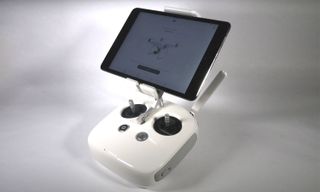
The controller connects to a phone or tablet through a USB cable. No cable is included, but no special cable is required. The same USB cable used to charge your Android phone or iOS device can be plugged straight into the USB host port on the back of the controller.
The DJI Go app shows the video preview from the quadcopter, as well as information about the drone's current status, including altitude, speed and battery level. The camera controls are on the right of this screen, including a big red button that starts and stops video recording, duplicating the recording button on the controller. This screen feels rather cluttered and confusing, but these controls and information can be dismissed with an upward swipe if you want to focus on the video preview. At the bottom right is a GPS map, which you can enlarge with a tap to fill the screen.
Flying
Flying Phantoms has always been a simple process, and the Phantom 4 continues this hassle-free flight experience. Once the Phantom 4 is ready to fly, you just press the takeoff button in the app and slide an on-screen switch to confirm. The quadcopter starts the motors, takes off and hovers about 3 feet off the ground. When you use the control sticks, the quadcopter responds quickly and smoothly, shifting as requested but without sudden jerks or starts. When you want to land the drone, hit the return-home button; the Phantom 4 will fly back to the location where it took off and will land gently.
Once you've got the hang of basic flight, you can start using the flight modes, which can be accessed through a switch on the controller or in the app. There are three oddly named manual flight modes available from a switch on the controller: Positioning, Sport and Attitude. Each mode sets which features and limits are enabled on the quadcopter. Positioning (or P) mode enables everything, with the quadcopter using GPS and all of the various object sensors, while restricting the speed of climbs and turns for slower, safer flight. As the name suggests, this mode focuses on putting the quadcopter into a specific position for taking a video or photo.

Sport (or S) mode enables the GPS and vision positioning but turns off the front obstacle-sensing system. The emphasis here is on fast maneuvering, allowing the quadcopter to reach its full speed of up to 45 mph. Attitude (or A) mode turns off most of the sensors, except for the barometer, which the quadcopter uses to measure altitude. This would be used in situations such as flying indoors, where GPS isn't available and you want to fly close to objects under manual control.
MORE: Best Drones of 2016
The Sport mode is impressively fast and responsive, allowing the Phantom 4 to fly at very high speed and turn and maneuver very aggressively. It's not a racing drone, but it is fast. Push the left stick forward, and the quadcopter will fly away like a rabbit from a fox. I clocked it at about 33 mph, and I wouldn't dispute DJI's claim of a maximum speed of 45 mph. This thing is very, very fast when it gets going.
With great speed comes great responsibility, though. With the object-avoidance system disabled in Sport mode, it is very easy to underestimate the speed of the thing and not stop it in time, whacking it into a tree, the ground or anything else unlucky enough to be in the way. I did crash the Phantom 4 a couple of times when flying in this mode, but it stood up to these crashes well; the worst that happened was that a rotor blade broke when the drone hit a thick branch.
When you are in the Position mode, the object-avoidance system is enabled, and it works very well. It consistently detected objects — including people, trees and sticks — and stopped the quadcopter before it crashed into them. You get a visual indication on the top of the live view of the app: A green bar indicates the path is clear, yellow means there's a warning and red with an audible tone means an object is getting very close, at which point the quadcopter takes over to prevent it from crashing.
The object-avoidance feature isn't perfect, though. It can't detect very small objects, such as hanging wires that could get caught in the rotors, and it only works with objects right in front of the quadcopter. If the quadcopter is sliding left or right, moving backward or moving up, it can't detect anything, and will happily crash into them.
Autonomous Flying
The Phantom 4 offers several intelligent flight modes in the app that make it more autonomous — in other words, flying without the direct control of the pilot. These compare favorably with the similar modes of the 3DR Solo, but the Solo's smart modes are more polished and easier to use, and more focused on getting good shots, rather than showing off the fancy features of the drone. The Phantom 4's intelligent flight modes include TapFly, Active Track and Intelligent mode.
In TapFly mode, the idea is that you tap on a destination in the live camera view in the app, and the quadcopter flies toward it, using the object-avoidance system to watch out for birds, trees or people in the way. If your target is below the horizon, the quadcopter slowly descends toward it, rather like it was flying on a cable. This mode is similar to the cable-cam mode of the 3DR Solo, and is good for filmmakers looking for a classic zoom-in shot.
Active Track mode is interesting. Here, you tap an object on the screen, and the quadcopter uses its built-in computer vision to try to follow the target as it moves. It does so using a combination of tilting the gimbal and moving the quadcopter itself. If the target moves, the quadcopter moves to keep the target centered in the frame.
This mode has a distinctly Terminator feel to it, but frustratingly, it sometimes loses track of the target. Things like shadows and changing light confused the tracking system during our testing. If the drone loses track, it hovers in place until the target moves back into the tracking area, which isn't much use if you are trying to track something uncooperative. We also found that differently colored clothing confused the tracking system as well; if you tracked someone from behind, wearing a dark jacket, and the other person turned around to reveal a lighter shirt, the system would often lose its track. So much for the TV cliché of the remorseless tracking drone hunter-killer approach; it is more of a hopefully-follow-and-often-lose-track approach.
The pilot still has some control when using Active Track. If you move the quadcopter left or right while tracking an object, the quadcopter will orbit around it, still tracking and moving the quadcopter to respond. You can also change the altitude, lifting or lowering the quadcopter while the tracking is still engaged. This definitely makes for some interesting shots; for instance, you could shoot an orbit shot around a motorbike heading down the road.
The object-avoidance feature isn't perfect; it can't detect very small objects such as hanging wires.
The Intelligent mode includes a number of more conventional submodes, such as the Follow Me mode, which follows the controller using GPS. There is also a Home Lock mode, which sets the quadcopter to orbit around the home point set in the app; and a Course Lock mode, which locks the quadcopter into a designated heading. Also included is a powerful Waypoint mode, which allows you to set multiple waypoints on a GPS map and navigate automatically between them. This mode was easy to use and worked well; it was easy to create the waypoints in the app and send the drone speeding between them.
Photos & Video
There is just a single model of the Phantom 4, which comes with a dedicated 4K camera. It captures excellent-quality photos and video; both were impressively sharp and clean, with plenty of detail.
The gimbal also did an excellent job of cushioning the camera from the shaking and twisting of the quadcopter body. The video remained sharp and clean, even when the quadcopter maneuvered at high speeds. We did notice that the camera occasionally caught sight of the rotor blades, though, even in the P flight mode, which is supposed to avoid this. Using the left control dial on the shoulder of the controller, you can tilt the camera up by 20 degrees or down by 90 degrees to point directly below. When we tried this, the camera responded quickly and smoothly.
This impressively small camera can capture 4K video at a resolution of 4096 x 2170 pixels at 24 frames per second, or a slightly lower 4K resolution (3840 x 2160) at 30 fps. You can also capture HD video at up to 120 fps and still images at 12-megapixels. The camera settings are controlled from the app, and both stills and video are stored on a microSD card that fits into the camera body. You can transfer media by either removing this card and using a card reader, or plugging a micro-USB cable into the socket. In the latter case, the quadcopter appears as a USB storage drive, and you can drag and drop images off it.
MORE: Axis Vidius Drone Review - Tom's Guide
It is tempting to shoot everything at 4K and shrink it down later, but these files get very large. Every minute of video at the highest 4K resolution takes about half a gigabyte of space. To record during an entire charge, you would fill a 16GB card to capacity. No card is included with the Phantom 4, but you can pick up a 32GB card for around $10 or $15.
Battery Life
The Phantom 4 has a slightly larger battery than its predecessor, holding 5,350 mAh of juice. That's a 10 percent increase over the battery in the Phantom 3, which translates into a slightly longer battery life. DJI claims a battery life of about 28 minutes, but we found that about 25 minutes was a more consistent average.
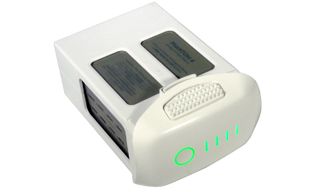
That's about 4 minutes more than the Phantom 3, and a little bit longer than the 22 minutes we got from the 3D Robotics Solo. However, it is worth remembering that the battery life of a drone depends on how you use it; fast maneuvering and climbing will mean a shorter battery life than simple hovering.
The large battery of the Phantom 4 holds a lot of charge, but it also takes a long time to refill. Using the charger included with the drone, the battery took a lengthy 1 hour and 15 minutes to recharge — about 20 minutes longer than the Phantom 3.
Repairability and Parts
Sadly, those who have invested in batteries and other accessories for older Phantom 3 models are out in the cold, as the newer model is not compatible. At this time, there are no third-party batteries available for the Phantom 4, but they will no doubt be available in time, as they were for the Phantom 3.

The Phantom 4's rotor blades are very easy to remove and replace: Just push down on the central hub of the blades and twist to make them pop straight off. That makes it very quick to replace a rotor, which is important if you are using this drone for commercial purposes. Two full sets of rotors are included with the Phantom 4, with additional sets of rotors costing about $18.
The large batteries are also easy to remove and replace; they snap tightly into place but are easy to take out by holding down the clips and pulling. The price is a little harder to cope with, though: A spare battery costs a steep $169.
Bottom Line
There's a lot to like in the Phantom 4. It shoots very-high-quality video that looks significantly sharper than what you get from the Phantom 3 and as good as the video from a 3DR Solo using a GoPro 4. The Phantom 4 is very easy to fly, even for novice users. Once you get familiar with flying the Phantom 4, you can switch to Sport mode and fly at impressive (and rather scary) speeds. The obstacle-avoidance system also works pretty much as advertised, spotting and avoiding obstacles in front of the quadcopter. And the active tracking system, while not perfect, also works well enough, generally succeeding at tracking people and other objects from the camera.
The Phantom 4's modes enable and disable features such as the obstacle avoidance in a seemingly arbitrary way, and flying in each mode is quite a different experience. Switching from Position mode to Sport mode feels rather like going straight from riding a moped in a driveway to riding a Harley on the highway, without anything in between: The controls are more sensitive, and the quadcopter flies much more aggressively. But overall, the Phantom 4 is an excellent package for both casual fliers and would-be airborne video shooters: It is simple to fly, takes great video and is hard to crash.
Sign up to get the BEST of Tom’s Guide direct to your inbox.
Upgrade your life with a daily dose of the biggest tech news, lifestyle hacks and our curated analysis. Be the first to know about cutting-edge gadgets and the hottest deals.
Richard Baguley has been working as a technology writer and journalist since 1993. As well as contributing to Tom's Guide, he writes for Cnet, T3, Wired and many other publications.
